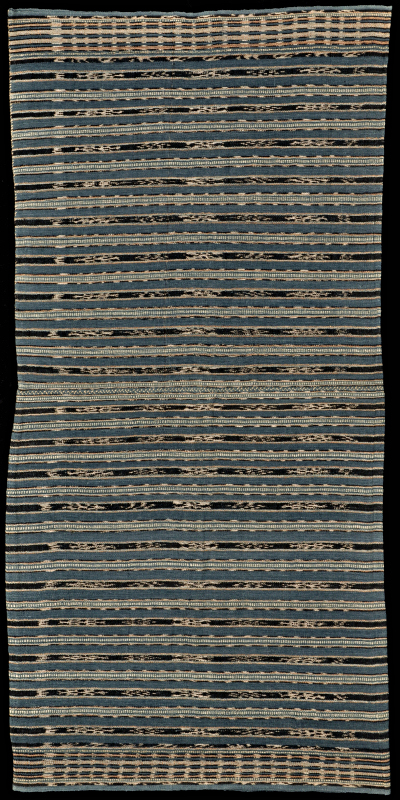| |
 
 | | | |
079 Moluccas, Tanimbar
Tais (sarong)  
| | Locale: | Specific island in the archipelago as yet unidentified, but probably Yamdena. | | Period: | 1940 | | Yarn: | Lontar fibre or coarse cotton, or mixture | | Technique: | Warp ikat | | Panels: | 2 | | Size: | 63 x 131 cm (2' 0" x 4' 3") LW: 2.08 | | Weight: | 515 g (18.2 oz), 312 g/m2 (1.02 oz/ft2) | | Design: | Tais sikatim in local Yamdena language, bakan inelak in Fordata, tais bakan in Selaru. Narrow bands with shimmering patterns in white on dark shades of indigo, probably a very narrow version of the lizard motif, alternated with narrow bands and stripes in light indigo, mauve and white. The lizard motif stands for links to the ancestors. If one describes a plan and a lizard shrieks, it means that the ancestors disapprove. The scorpion motif protects against bites. The arrows, built losely of dots, represent the mythical hero Atuf who with one throw of his spear seperated earth from heaven. It is propotious for war and hunt. The dots on the side of stripes protect the village from assaults. | | Comment: | The most common type of Tanimbar sarong. Hard to find early example in good condition. Colours somewhat faded but attractive. Very loose, almost gauzy weaving, which feels a little rough to the touch, most likely because of the use of fibre made from lontar palm leaf - possibly mixed with cotton. | | Background: | Chapters on Moluccas and Tanimbar. | | Compare: | 080 165 173 | | Sources: | Very similar to pre-1926 Yamdena sarongs in Tropenmuseum, Nr. TM-329-3 and TM-328-22. Also similar to pre-1931 sarong TM-694-18. Similar to bakan depicted in Khan Majlis, Indonesische Textilien, Wege zu Goettern und Ahnen, Fig. 595. Lizard motif in Van Vuuren, Ikat from Tanimbar, Fig. 57, p. 128. Scorpion motif on Fig. 92, pg. 131. Information on motifs and meaning provided by Marianne van Vuuren. � | | |

©Peter ten Hoopen, 2025
All rights reserved.
|
|


